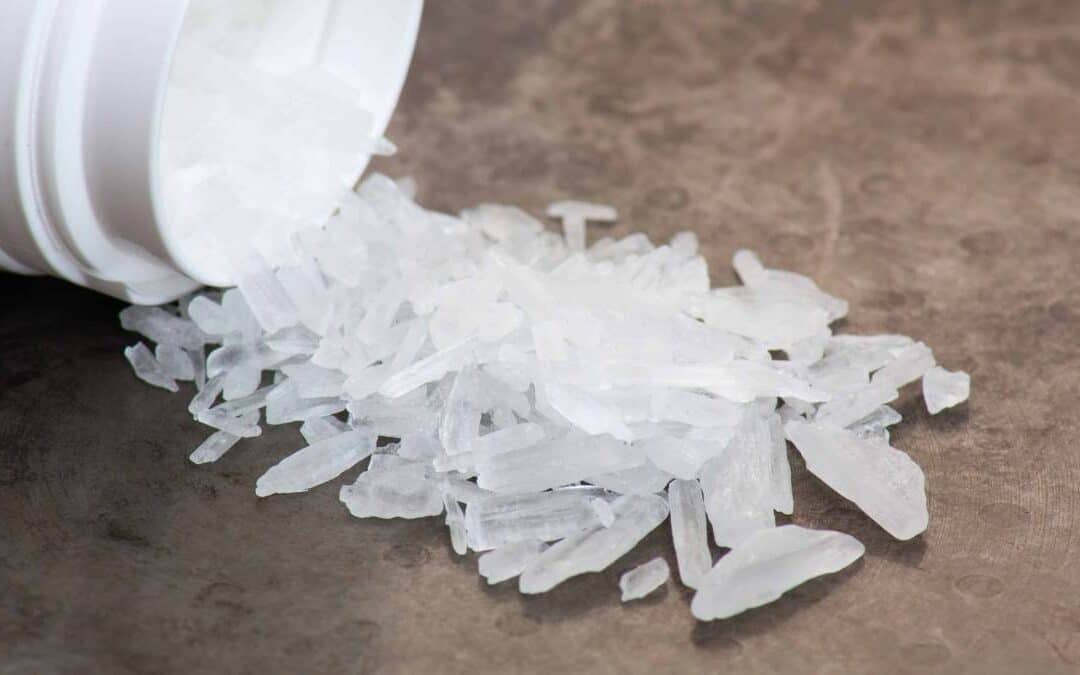The distinction between meth vs. crystal meth lies in how and why people make them.
Meth and crystal meth both produce a long-lasting euphoric high. Unfortunately, both drugs are highly addictive and potentially deadly. The physical and mental effects of addiction to both drugs are devastating.
There are different types of meth that one should learn about as it affects their loved ones and communities. For example, what is crank meth? What is the difference between meth and ice? At Detox West Tennessee, we’ll delve into it below.
What’s the Difference? Meth Vs. Crystal Meth
Many people use the names of different types of meth interchangeably; however, stark differences exist between them.
So, what is the difference between meth and crystal meth?
Methamphetamine, a stimulant, is manufactured by pharmaceutical companies in pill form or a white powder. Meth abuse, however, is illegal. Street names for meth include chalk, crank, and yellow powder. Meth affects the nervous system and alters brain chemistry. Meth is highly addictive and produces a highly energized state with a long-lasting high.
Crystal meth is the purest, illicit form of methamphetamine, but unlike meth, it is produced illegally with uncertain ingredients. Street names for crystal meth include ice, glass, and speed, and it resembles rock or glass in appearance. Another difference between crystal meth and meth is how people use the drug. Crystal meth can be taken by mouth orally as a pill or dissolved powder into an injectable liquid form. Other ways to use crystal meth include snorting and smoking.
The powder form of meth or speed can contain additives and produces an intense high, but not as strong and quick acting as crystal meth. Base, another form of meth, is a sticky, oily substance injected or swallowed and is not as pure as ice or crystal meth. Higher purity produces a more intense high and increases the addictive risk.
Another difference when analyzing meth vs. crystal meth lies in their risk of overdose. As potency increases, toxicity increases and overdose is more probable. When the purity of meth increases, dopamine production increases, which leads to binging behaviors. These continual urges to use can result in a higher risk of overdose and death.
Difference Between Meth and Ice
Methamphetamine was originally developed as a stimulant to treat disorders such as Attention Deficit Hyperactivity Disorder (ADHD) and some eating disorders. Pharmaceutical labs manufacture meth using legitimate ingredients, and the drug is legal with a prescription.
People make crystal meth in illicit home labs from various over-the-counter components. One essential difference between the two drugs is the legality and intention.
Methamphetamine (commonly known as meth) and crystal methamphetamine (referred to as ice) are two forms of the same powerful stimulant drug. They differ in their physical state and purity.
Meth typically exists as a powder or pill, while ice is a crystalline form of the drug, hence its name. Ice is known for its high potency and purity, making it a more potent and addictive variant of meth.
Both substances have severe health risks and can lead to addiction, mental health issues, and physical harm when abused.
What is Crank Meth?
Crank meth, also known as “crank,” is a slang term for a low-quality and impure form of methamphetamine. It is often produced illicitly in clandestine laboratories and is notorious for its unpredictable purity and potency.
Crank is typically found in powder or crystalline form and is commonly ingested, snorted, or injected by users seeking a stimulating and euphoric high. However, due to its impurities and inconsistent quality, crank can be particularly dangerous, leading to a range of adverse health effects and increased risks of addiction.
The term “crank” is sometimes used to describe street-grade methamphetamine that lacks the refinement and quality control found in pharmaceutical-grade versions, making it a dangerous substance to use.
Side Effects of Meth vs. Crystal Meth Abuse and Addiction
Meth addiction is dangerous and can lead to overdose and death. Recent studies reveal that nine out of ten people who illegally use meth get hooked the first time. This long-term high can continue from long hours to days.
One difference between these drugs is the length and intensity of their highs. The side effects of meth vs. crystal meth addiction can be any of the following signs and symptoms:
- Disruption of eating and sleeping habits
- Anxiety, aggression, hyperactivity
- Grinding of teeth
- Meth mouth, dental devastation
- Bacterial infections
- Psychosis, paranoia, hallucinations, and delusions
- Weight loss
- Skin sores
Differences in Paraphernalia
Differences also lie in the paraphernalia incorporated into usage and can be a clue to distinguish what type of meth addiction is present. With speed or crank, users use rolled-up paper money, small mirrors, razor blades, syringes, needles, or empty capsules. Ice or crystal meth offers more options for ingestion. Users may use glass pipes and lighters in addition to the same tools that disperse powder form.
Availability varies in geographic regions, making a big difference in what is available. But, more importantly, the difference between the two drugs and the risks involved are the addiction’s longevity and the drug’s intensity.
In addition, poor oral health, psychiatric disorders, and physical deterioration can occur with the use of both forms of meth.
In conclusion, treatment is more challenging, and long-term addiction can complicate detox.
Treatments for Crystal Meth vs. Meth
When it comes to methamphetamine vs. crystal meth, drug detox and treatment are minimal. Meth addiction can be dangerous and challenging to treat. Medically monitored detox may include drugs to minimize the uncomfortable symptoms experienced in withdrawal. However, the withdrawal symptoms can be severe, and detoxing yourself with meth addiction is inadvisable.
Common withdrawal symptoms can begin within twenty-four hours of the last use. Withdrawal from meth addiction can include any combination of the following symptoms:
- Immediate loss of pleasure leading to feeling depressed
- Fatigue and extreme tiredness
- Anger and anxiety
- Confusion and headaches
- Hallucinations
- Sleep disruptions
- Extreme hunger
Withdrawal symptoms can last from weeks to months. The difference between these two drugs becomes apparent in treatment and recovery. After all, crystal meth can incur a longer recovery time, and the person trying to recover may feel the urge to use it for longer.
Essential for healing is individual therapy to investigate the reasons addiction occurred, identify triggers, and initiate positive, healthy coping mechanisms.
Additionally, group and family therapy will add depth to the treatment program.
Find Help for Meth Addiction in Tennessee
Do you need more information on meth vs. crystal meth? Are you experiencing an out-of-control addiction? If you or a loved one seems lost and overwhelmed by their addiction, Detox West Tennessee can help. Our professional treatment experts are familiar with the enormity of meth addiction and can explain medically monitored detox options. So begin your journey of hope and sobriety with one of our individualized treatment plans. Contact us today.




